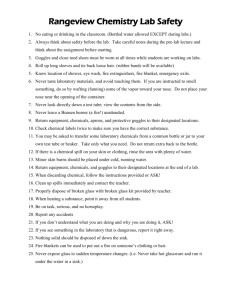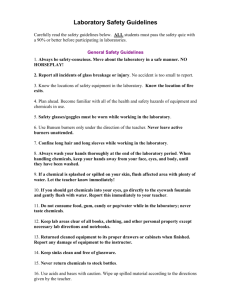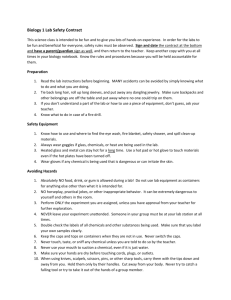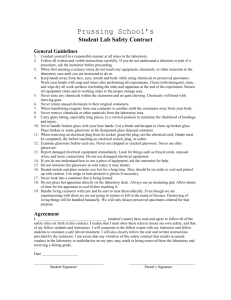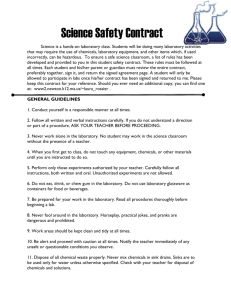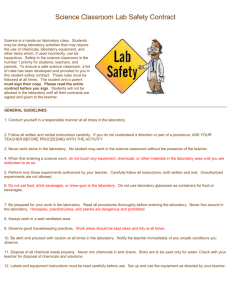Chemistry Lab Safety: Rules, First Aid, & Equipment
advertisement
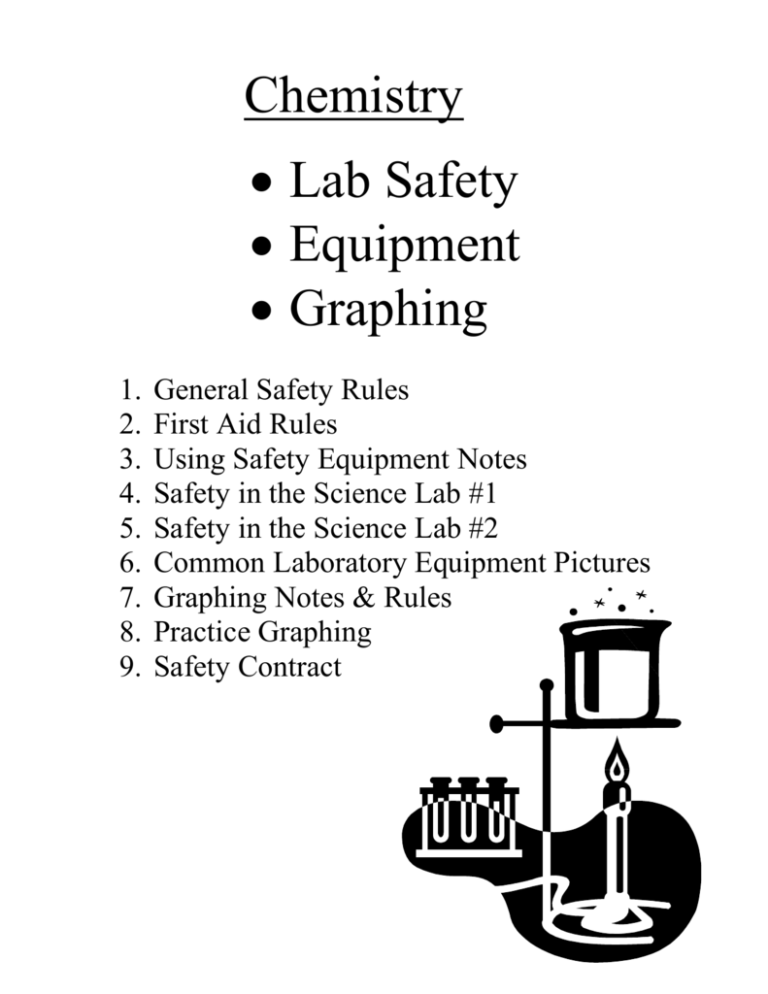
Chemistry Lab Safety Equipment Graphing 1. 2. 3. 4. 5. 6. 7. 8. 9. General Safety Rules First Aid Rules Using Safety Equipment Notes Safety in the Science Lab #1 Safety in the Science Lab #2 Common Laboratory Equipment Pictures Graphing Notes & Rules Practice Graphing Safety Contract Safety in the Science Laboratory In the laboratory, you will be working with equipment and materials that can cause injury if they are not handled properly. However, the laboratory can be a safe place to work if you are careful. Accidents do not just happen; they are caused – by carelessness, haste, and disregard of safety rules and practices. Safety rules to be followed in the laboratory are listed below. Before beginning any lab work, read these rules, learn them, and follow them carefully. If you have any questions about these rules, ask your teacher before stating lab work. General Precautions: 1. 2. 3. 4. 5. Be prepared to work when you arrive in the laboratory. Read the lab procedures before beginning. Carefully follow all oral and written instructions. Never do any unauthorized experiments. Notify your teacher of any medical problems, like allergies or asthma, before beginning the lab. Never eat or drink during lab. Keep your work area tidy. Only items necessary for the experiment should be on the lab counter. Place purses & backpacks on your seat out of the aisles. 6. Dress appropriately for lab. a. Always wear goggles and a lab apron. b. Tie back long hair. c. Wear closed-toed shoes. d. Do not wear loose clothing, like ties or shirts with baggy sleeves. e. Do not wear dangling jewelry, including lanyards. f. Avoid wearing contacts on lab days. 7. Do not engage in horseplay. 8. Set up the apparatus as described by your teacher. 9. Use the prescribed instrument for handling the apparatus. Ex) beaker tongs or test tube clamp 10. Keep all combustible materials away from the flame. 11. Never smell any chemical directly. When testing for odors, use a wafting motion to direct the odors to your nose. 12. Conduct any experiment involving poisonous vapors in the fume hood. 13. Dispose of waste materials as instructed by your teacher. 14. Use a sponge to clean your work area and wash your hands thoroughly when done. Handling Chemicals: 15. Read and double-check labels on chemical bottles before removing any chemical. 16. Take only as much chemical as you need. 17. To avoid contamination, do not return any unused chemicals to stock bottles. 18. Avoid touching chemicals with your hands. If you do, wash them immediately. 19. When mixing an acid and water, always Add the Acid to the water, never the reverse. 1 Handling Glassware: 20. When inserting a thermometer or piece of glassware into a rubber stopper, lubricate the glass to avoid breakage. 21. Do not place hot glassware directly on the table. 22. Allow hot glassware time to cool before touching it. Remember hot glass looks like cool glass! 23. Never handle broken glass with your hands. Use the dust pan and brush. Dispose in the cardboard container. Heating Substances: 24. Use extreme caution with the gas burners. Keep your head and clothing away from the flame. 25. Never leave a burner unattended. One partner must stay with the burner at all times. 26. Never heat anything unless instructed to do so. 27. When heating a substance in a test tube, point the mouth of the test tube away from yourself or anyone else. Never look into a container that is being heated. 28. Never heat a closed container. If an Emergency Occurs: 29. If an injury should occur, it is important to remain calm. 30. Notify your instructor immediately if there is an injury or spill. 31. Be familiar with first-aid practices. 32. Know the location and proper use of emergency equipment such as the fire extinguisher, shower, eye wash and fire blanket. 33. Know how to summon assistance. 2 First Aid in the Chemistry Laboratory Accidents do not often happen in well-equipped chemistry laboratories if students understand safe laboratory procedures and are careful to follow them. When an occasional accident does occur, it is likely to be a minor one. In our school, the nurse is responsible for treating injuries. However, for some types of injuries, you must take immediate action, before the nurse takes over. ALWAYS NOTIFY YOUR TEACHER IF THERE IS AN INJURY IN THE CLASSROOM, NO MATTER HOW MINOR IT MAY SEEM! Bleeding from a Cut: 1. 2. 3. 4. Wash the cut with cold water to remove any possible contaminants or glass. Apply pressure to the wound with a clean, absorbent cloth. If bleeding continues, raise the body part above your heart and continue applying pressure. Take the victim to the nurse or call for help. Burn from Hot Substance: 1. Immediately run the burn under cold water. 2. Notify the teacher and go to the nurse. Acid or Base Spilled on the Skin: 1. Remove all clothing that has the chemical on it. 2. Flush the skin with water for 15 minutes with either faucet or shower. Chemicals in the Mouth: 1. Immediately spit out any chemical and rinse the mouth with water. (Do not swallow the water.) 2. Note the name of the chemical and notify the nurse immediately. 3. If necessary, the nurse will contact Poison Control or another healthcare provider for instructions. Chemicals in Eyes: 1. 2. 3. 4. Begin flushing your eyes in the eye wash for 15 minutes. If you are wearing contacts, remove them immediately. Keep your eyes open and allow the water to roll around in your eyes. Do NOT attempt to go to the nurse’s office before flushing your eyes. Clothing or Hair on Fire: 1. Use the faucets around the room to douse a small fire, if the person is engulfed in flames, use the shower. 2. If the water is not working, use the fire blanket to smother out the fire. 3. Remember the saying: Stop, Drop, and Roll. 3 Breathing Smoke & Chemical Fumes: 1. Experiments with noxious fumes should be conducted in the fume hood. 2. If fumes exist in the laboratory, immediately leave the lab. Shock: 1. People who are suffering from any severe injury (like a bad burn) may be in a state of shock. A person in shock is usually pale and faint. The person may be sweating, with cold, moist skin and a weak rapid pulse. 2. Shock is a serious medical condition. Do NOT allow a person in shock to walk anywhere – even to the nurse’s office. Call for emergency help immediately. 4 Using Safety Equipment in the Room Fire Extinguisher: 1. 2. 3. 4. Eye Wash: 1. 2. 3. Fire Blanket: 1. Safety Shower: 1. 2. Goggles: 1. 5 6 Safety in the Science Lab #1 Part I: Match the description with the correct safety symbol. Not every symbol is used. ______ 1. Protect your eyes at all times. ______ 2. Avoid contact: corrosive material. ______ 3. Special disposal instructions. ______ 4. Hot object: use tongs. ______ 5. Protect your clothing. ______ 6. Danger: radioactive material. ______ 7. Protect hair and clothing from open flame. ______ 8. Handle with care: guard against glass breakage. Part II: Answer each of the following questions in the space provided. 9. Describe the sequence of actions you should take if you spill a strong acid on your clothing in the lab. __________________________________________________________________________________ __________________________________________________________________________________ 10. Why is water a good choice for diluting unknown liquids that have spilled in the lab? _________________________________________________________________________________ _________________________________________________________________________________ 11. Describe what to do if your shirt-sleeve caught on fire? _________________________________________________________________________________ _________________________________________________________________________________ 12. Describe what to do if you cut your hand badly? _________________________________________________________________________________ _________________________________________________________________________________ 7 13. Describe what you would do to help your lab partner if he or she got chemicals in their mouth? __________________________________________________________________________________ __________________________________________________________________________________ 14. Describe common symptoms of those who are in shock. __________________________________________________________________________________ __________________________________________________________________________________ 15. What is the most important lab safety rule? ______________________________________________ 16. Draw a sketch of your chemistry laboratory below and mark the locations of these items: fire extinguisher emergency exits safety shower fire blanket eyewash neutralizing solutions aprons goggles fume hood 8 Safety in the Science Lab #2 Directions: Use the words or phrases below to correctly complete the statements below. follow the rules goggles horseplay long hair immediately broken glass beaker tongs pressure shower and eye wash spatulas (spoons) safety wafting test tubes flammable contamination acid 1. Chemicals that are _____________________ should never be used near an open flame. 2. __________________________ should be heated using a gentle, back and forth motion. 3. Safety in the science laboratory can be achieved when students ___________________________. 4. All accidents no matter how small should be reported ________________________ to the teacher. 5. Never exert ___________________ when inserting glass tubing into a rubber stopper, always lubricate the glass with glycerin first. 6. Students should wear _______________ whenever working with chemicals, flames or equipment in the science laboratory. 7. Before beginning any work or experimenting in the laboratory, it is important to know the location and operation of the _____________________________________. 8. Dispose of ______________________________ in the cardboard box in the front of the room. 9. Use _____________________________ when handling hot beakers. 10. _______________________ should be tied back when working with lit Bunsen burners and other combustible materials. 11. Careless housekeeping practices can result in possible ________________________ of chemicals being used. 12. Odors produced from heating chemicals should be detected by ________________ the vapors gently toward the face. 13. Serious accidents can result when students misbehave and engage in ___________________ in the laboratory. 14. Only clean _______________________ should be used to remove chemicals from stock bottles. 15. If you need to dilute acid always add the ______________ to the water, never the reverse. 16. ______________________ is everyone’s business in the science laboratory. 9 Common Laboratory Equipment 10 11 Equipment Naming Practice: 12 Graphing Notes: Factors in an experiment: 1. Independent variable: 2. Dependent variable: 3. Experimental Control: *Note: Bar graphs are for “counted data” line graphs are for “measured data.” 13 THE RULES FOR PROPER GRAPHING Graph: A diagram representing a system of connections or relationships among two or more quantities. Steps for Plotting a Quality Graph 1. Identify the independent/dependent variables. The independent variable will be plotted on the xaxis and the dependent variable will be plotted on the y-axis. Independent is the controlled variable or quantity you chose the increments. Dependent changes due to a change in increments. *Time is most common independent variable. 2. Look at the data and choose the best orientation for the graph paper. 3. Draw the y-axis 2-3 bocks in from the left side of the paper. Draw the x-axis 2-3 blocks up from the bottom of the paper and extend it from the end of the y-axis to the right side of the graph. 4. Choose a scale so the graph is large enough to fill most of the available space on the paper, but one that is easy to use. *At least 50% of each axis should be used. 5. Each regularly spaced division on the graph paper should equal some convenient, constant value. In general, each interval should have a value that can be easily divided visually such as 1, 2, 5, or 10, rather than a value such as 3, 6, 7, or 9. 5. Label each axis with the name of the variable AND the unit. 6. Avoid a cluttered appearance! Do NOT number every space…keep it clean. 7. Plot each point as a small dark point and not a large dark circle. 8. Before drawing your line, consider whether the origin (0,0) is a valid point for your experiment. 9. If the data appears to lie roughly in a straight line, draw a best-fit line with a ruler that best represents all points. DO NOT connect the dots! If the data looks more like a curve, draw a SMOOTH best-fit curve. *Best fit lines should be a single, smooth line. 10. “Outliers” – numbers which do not fit the general trend of the data may be ignored if you have enough trials. 11. If your graph is showing multiple trials or items, use a key or legend to distinguish one best fit line from another. 12. The final step to all graphs is the title. The title should be placed at the top in an area free of data. The title should describe with some detail EXACTLY what the graph is showing (sentence or statement). Titles should NOT be “X” vs. “Y”. Interpreting Graphs 1. Sometimes you need info about a value that you have not determined experimentally. Reading from the graph between data points is called interpolation. Reading from your graph beyond the limits of your experimental results (extending) is called extrapolation. 2. Show data from experimental results with a solid line. Extrapolated data should be shown with a dashed line. 3. Some common graphical relationships (and their equations) that occur in chemistry are the: Direct relationship y = kx Inverse relationship y = k/x Constant relationship y=k Exponential relationship y = x2 14 DO NOT “Connect the dots!” Follow the general trend for the graph…see below. INCORRECT!!! ! CORRECT!! !! Some data may be “outliers” it can be ignored when following the general trend of the data: Draw a “best fit” line for this graph: 15 Practice Graphing: Follow the rules from Page 14. Extrapolate the data for 7L for each trial. Title: ___________________________________________ Data Trial #1: Volume Pressure (L) (atm) 0.5 120. 1.0 90. 2.0 65 3.0 45 4.0 35 5.0 32 6.0 30. Data Trial #2: Volume Pressure (L) (atm) 0.5 100. 1.0 72. 2.0 48 3.0 34 4.0 24 5.0 20 6.0 18 Statement: This graph shows as ________________ __________________________________________ 16 Safety Contract After you have read all the safety information in this laboratory manual and are sure you understand the rules, fill out the safety contract below. Signing this contract tells your teacher you are aware of the rules of the laboratory. The signature of your parent or guardian indicates an awareness of the school laboratory rules. Return this signed contract to your teacher. Safety Contract I, _______________________________, have read the safety rules contained in this packet. I understand the contents completely and agree to comply with all the safety rules and guidelines that have been established in each of the following categories: Please Check (√) ______ General Precautions ______ Heating Substances ______ Handling Chemicals ______ First Aid ______ Handling Glassware ______ Emergency Equipment __________________________________________ Student Signature __________________ Date __________________________________________ Parent Signature __________________ Date 17
